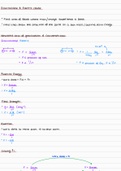Resume
Volledige samenvatting Current Issues in Historical Perspective
- Établissement
- Katholieke Universiteit Leuven (KU Leuven)
Dit is mijn samenvatting van het vak Current Issues in Historical Perspective, met als basis de slides, uitgebreid aangevuld met notities van tijdens de les (excl. les over Oost-Europa). Ik behaalde een 13/20 in eerste zit, met deze samenvatting.
[Montrer plus]











